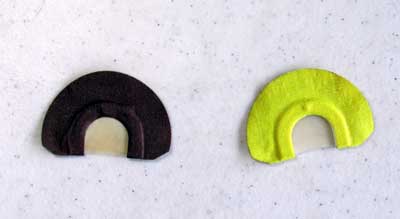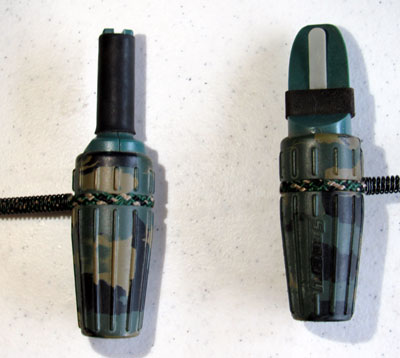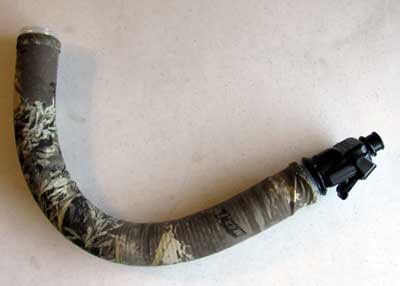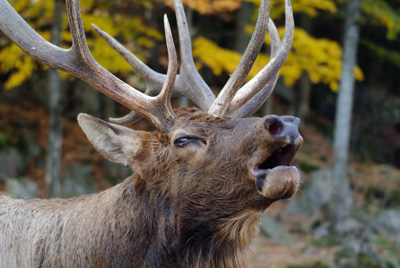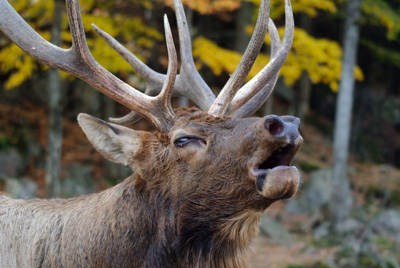
Elk Call
Using an elk call to locate and attract elk is one of the most exciting things about hunting elk, especially in the rut. Even if you are not hunting during the rut, it is still an important tactic to have an elk call available and know how to use it.
Elk are probably the most vocal big game animal in North America. They communicate within the herd during normal daily activities. Cows “talk” to their calves, and vice versa. They issue warning calls when they see something suspicious. But the most famous elk call of all, is the bugle of the bull elk during the rut.
As hunters it is important for us to understand what kind of sounds an elk will make, and under what conditions. We want to know what elk call will imitate a particular sound of an elk. And most of all, we want to know how to use our elk call to assist us in harvesting an elk during our hunt.
Types of Elk Calls
There are many types of elk calls on the market, and it pays to understand what is available and what are the pros and cons of each. Most hunters will want multiple elk calls in order to create different elk sounds to meet the needs of different situations. After trying several types of elk calls most hunters will settle on their own personal favorites.
Diaphragm
A longtime favorite of turkey hunters, this design is the most versatile elk call on the market. A diaphragm call is a thin horse shoe shaped device with one or more latex strips stretched across the center. With slight variations in design, and skill of the user, this call can mimic virtually all of the elk sounds a hunter will want to imitate. Since the call is held entirely inside the hunter’s mouth, hands are free to operate a weapon or optics. When you want to stop an unsuspecting elk from moving in order to get a clear shot, having a diaphragm call in your mouth and making a soft cow call will usually stop an elk in his tracks to give a curious look in your direction.
The downside of this type of elk call is that it is also probably the most difficult to master. Some people have a sensitive gag reflex that is triggered by having something “foreign” in their mouths. However, proper placement of the diaphragm call is in the front of the mouth and does not trigger a gag response in most people. Even though it takes lots of practice to use this elk call effectively, its versatility makes it well worth the effort.
Reed
A Reed Call is a handheld device that requires the user to blow through it. As the air passes across a reed that is shaped appropriately, it will create the sound of an elk call. Different tones can be created depending on the design of the call. Some calls create different sounds by changing the pressure on the reed by tightening the lips and changing how hard the user is blowing on the call. Other designs require the hunter to apply pressure on the reed by squeezing the call. Reed calls are easy to learn to use, and require only a little practice. There are multiple variations of reed call designs that will create the full range of elk sounds to meet the needs of most elk hunting situations, including bugles.
The downside of reed calls is that they must be held in the hunter’s hand. This may not be an issue in most situations, but it is difficult if you need two hands on your weapon to be ready to shoot. Another negative about some designs of reed calls is that they can get “fouled” by the user’s saliva after extended use and fail to work. The problem is not permanent, as it will begin to work again when the reed dries. But it can be annoying when actively calling to have the elk call quit working.
Manual
This type of elk call is used by the hunter squeezing the call to force air across a reed. They are easy to use and are typically very reliable.
As with the reed calls described above, the biggest issue with this style of call is that it is not hands-free. This can be addressed to some extent by keeping the call on a lanyard so that it is handy, but can simply be dropped if needed. One of the most popular calls of this type is the Hoochie Mama, by Primos.
Bugle
A bugle is an elk call designed to sound like a bugling bull elk. It is usually a variation of a diaphragm call with a tube attached. The tube helps create the reverberating sound that a real elk will make while bugling. Varying the pressure on the latex of the diaphragm creates the different tones required to imitate a bull elk. Some designs include methods for manually changing the pressure on the latex. Sometimes the tube itself can be used with a regular diaphragm elk call to bugle, or even to make a cow call sound more realistic.
Electronic
There are apps available that will turn your smartphone into an electronic elk call. Use of this type of call is as simple as pushing a button, assuming that the user is familiar with the operation of the electronic device.
There are multiple cons with electronic elk calls. The sound may not be realistic or loud enough to be effective; not many cell phone lanyards are available that allow you to simply drop the phone if you need your hands; and the biggest drawback is that use of electronic calls for elk hunting is not legal in most states.
Mastering your elk call
While using an elk call can be extremely effective in locating and attracting elk, it does no good to have an elk call but be unable to use it well. In fact, a poor attempt at imitating an elk, can actually scare an elk away. Because of this, it’s important that you follow the two keys to mastering your elk call.
- Know what an elk sounds like – Obviously, if you are going to imitate the sound of an elk, you need to know what an elk sounds like. If you have spent time in elk country, you may have the sounds of an elk call burned into your brain. If not, you will need some help. Many of the calls available for purchase include a CD or DVD that give you some sounds to imitate. That can get you started, then as you hear the real thing, you will know what your elk call is supposed to sound like.
- Practice – Just as most people can’t play a musical instrument by simply listening to that instrument, you can’t expect to become proficient with an elk call without spending the time to figure out how to make it work. Find a place where you aren’t worried about sounding silly, listen to the sound you are trying to imitate, and go for it. After some trial and error, most people can get the hang of it. Don’t stop when you figure it out, continue until you get proficient. When you are close to an elk that you are trying to call, you don’t want to have two or three failed attempts at calls before you get it right.
Hunting with your elk call
The reason most of us are interested in elk calls is because we are hunting elk. Once you have determined what type of elk call you want to use, made your purchase, and practiced until you sound like an elk, then you need to know how to use it in a hunting situation.
Locating elk
There are times when elk will answer a call, but will not come. This is especially true before and after the rut, but also sometimes even in the peak of the rut, depending on the situation. When this occurs, your best bet may be to simply locate the elk with a call, then plan a silent stalk.
- Bugle – If all goes quiet during your hunt, try one or two bugles early in the morning or late in the evening. If you get no answer, change locations and try again. If you do get an answer, move in the direction of the bull and call again. Be careful and stop calling before you get too close. If a bull decides that another bull is moving in on his territory, he is likely to silently leave the area. Sometimes bulls will shut up and go to bed long before daylight and not begin bugling until well after dark. If you are confident elk are in the general area based on the sign that you see, try driving or climbing to a ridge top and bugling in the middle of the night. You obviously won’t be hunting at that time, but if you get a response it might give you a good clue where to be at first light the next morning.
- Cow Calls – Even though cow calls aren’t typically as loud as a bugle, sometimes elk can’t resist answering what they think is a cow elk. Also, a cow elk call can prevent you from surprising elk as you walk through the woods. Before entering that thicket of trees or dropping into that canyon, cow call a few times. You might get an answer that will alert you to be cautious. Finally, when walking through woods that are particularly noisy, cow call every now and then. Elk in the area may be fooled into believing that elk are making that noise, and not be scared.
Attracting elk
One of the exciting parts about elk hunting is that it is sometimes possible to call an elk to you by using an elk call. This is especially true during the rut, but is possible at other times too. Different calls work better in different situations.
- Cow call – Cow elk make many different sounds, but the main ones to imitate in order to attract elk are Cow and Calf mews, and Cow in Estrus
- Cow and Calf Mew – This elk call is the most common heard in the woods, and should be a standard for any elk hunter. Cows and calves communicate regularly and a cow call from an unknown “elk” will often cause elk to be curious enough to come and investigate. A bull elk during the rut may think you are a cow that has been attracted to his bugles, and he may come to check you out. If you are calling on the outskirts of an elk herd, be on the lookout for elk coming from any direction. Cows or satellite bulls may come in silently. If all of your attention is focused on the bugling herd bull, you may get caught by the other elk coming to you. Elk that are alone seem to be the most likely to come and check out a cow call, but pre-rut bulls may only be interested in answering your calls and not actually coming in. Be careful and don’t call too often. Real elk will usually call and then listen for a while. An effective elk hunter will do the same.
- Cow in Estrus – This type of elk call can be extremely effective during the rut. Bulls at the peak of their hormone levels may come running in to this call. A herd bull that is hesitant to leave the herd to check out a normal cow call may not be able to resist a Cow in Estrus call. Even if he doesn’t come in, he may bugle an answer to you. Unlike the standard cow call, this elk call can and should be used aggressively.
- Bugle – Since a bull elk bugle is the signature sound of the species, it is the elk call that most new hunters want to master. However, it is sometimes less effective at attracting bulls than cow calls. But there are certain situations where the right bugle can be bring a bull, or even a cow in for a shot.
- Big Bull – Most hunters want their bugle to sound like the biggest baddest bull in the country, but often this can do more harm than good. Most bulls will avoid a fight if they can, and herd bulls will often move their harem to avoid the risk of losing cows to another dominant bull. So a big bull bugle can simply chase bulls away. There is at least one situation where this elk call can be effective. If you are very close to a herd, and have approached silently, a big bugle can shock a bull into coming toward the call. He may think that he has no time to move his harem away, and needs to confront the interloper immediately. Just remember that he will come charging in spoiling for a fight.
- Little Bull – Most hunters will not have perfected the bugle to sound like a big bull, and that’s ok. Sounding like a small or average bull can be very effective. Satellite or lone bulls or even cows may come to check out the new bull on the block who is strutting his stuff. Herd bulls may come in to put a smaller bull in his place to show his dominance.

